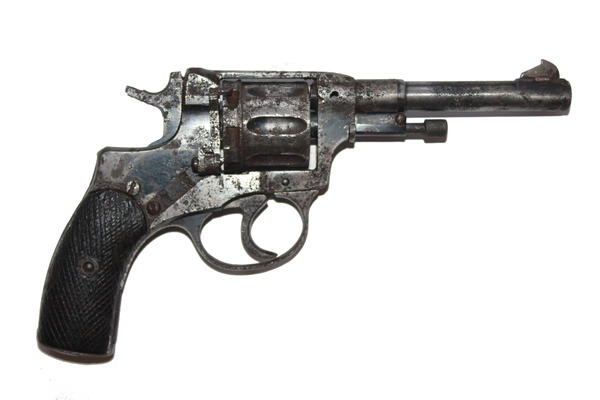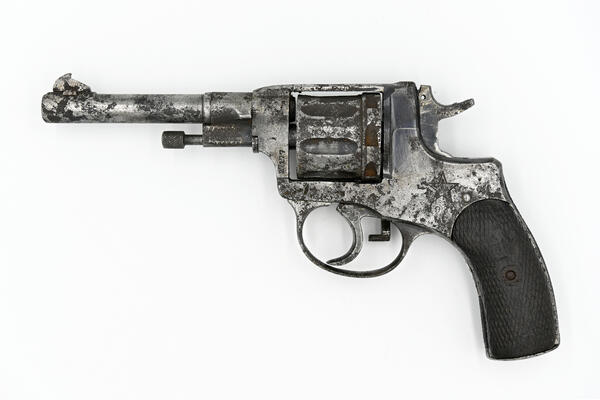A revolver made in the 1930s at the Tula Arms Factory is housed in the Polyarny Museum of History and Local Lore. During the Second World War, it belonged to a sailor who served on a cutter in the North Sea. It was then transferred to the room of Military Glory of the Northern Fleet Missile Launch Brigade located in the village of Granitny. After the dissolution of the settlement and the disbandment of the detachment, the revolver was transferred to the political department of the Kola Flotilla for storage. Then the revolver was transferred for permanent storage to the Polyarny Museum of History and Local Lore.
The revolver has a one-piece monolithic frame. The number 27,177 is stamped on the left side of the frame near the cylinder. The mechanism located in the frame is closed with a flat sideplate; a five-pointed star and “1930” (year of manufacture) are stamped on the lid at the handle. On the right side of the frame, above the handle, there is an embossed “C” inside a diamond shape, next to a five-pointed star. The gun has a tensioned double-action trigger, the firing pin is mounted on the hammer. It has a plate mainspring that consists of two leaf arms, placed in the handle. The sear is made from the same piece of steel as the trigger. There is no safety lock. This is mitigated by a special part that doesn’t allow the striker to come into contact with the bullet’s capsule if the trigger is not pressed.
The Nagant revolver was developed by Belgian gunsmiths, brothers Emil and Leon Nagant. In the late 19th — mid-20th centuries, it was produced and used by the military and law enforcement in several countries. The first revolvers were released in 1878 and were called “revolver model 1878”. Over time, this firearm gained more and more popularity as it combined simplicity of design, reliability and its ability to be fired repeatedly. Positive feedback from the Belgian army contributed to the popularity of the Nagant factory on the world market. Modifications of the revolver began to be produced by many gun companies around the world.
By the decree of Nicholas II from May 13, 1895, the Russian army adopted it under the name “Nagant system three-line revolver of the 1895 model”.
In the 1930s, the design of the revolver was modified. This model enjoyed a steady rate of production up until the beginning of the Second World War. The active use of the revolver by the Soviet Army in wartime is explained by several advantages of this type of weapon, including the absence of delays, high accuracy of shooting and a convenient handle. Its disadvantage was that it took a long time to reload.
After the end of the Great
Patriotic War, the Nagant was decommissioned by the Soviet Army, and its
production was discontinued, in particular due to an increase in the percentage
of defects and obsolescence of the design as a whole.





